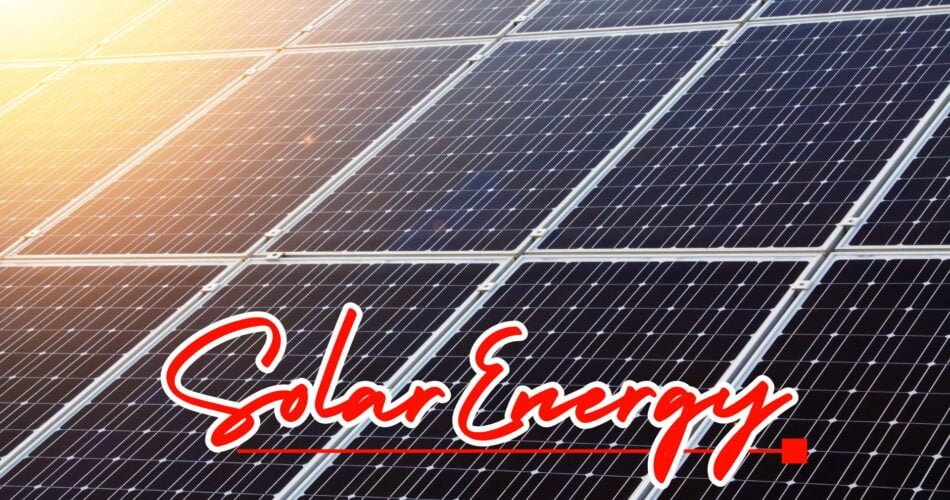This blog contains information about Solar Energy. In the start, it defines Energy and its forms. Then it explains what is Solar Energy and how it works. It also describes the Types of Solar Panels. Then it elaborates the the Types of Solar Energy in detail. It also discusses the Advantages and Disadvantages of Solar Energy. In the end, it informs the Price of Solar Systems in Pakistan. This blog contains Solar energy, its types, Advantages and Disadvantages in detail.
Definition of Energy:
Energy is the ability to do work. Energy is a quantitative property that is transferred to a body or physical system and it is recognized in performance of work.
Anything or ability that can perform some work is categorized as energy. This can be in many forms such as nuclear energy, solar energy, thermal energy, electrical energy etc. It has a distinctive property of transferring from one body to another and in this way energy works out. Every work need energy to get it completed. Whether its daily life works such as displacing an object from one place to another. Or on bigger levels energy is used to produce electricity, run machinery and for many other Industrial processes. In this blog we will have detailed study about Solar Energy.
What is called Solar Energy?
Solar energy or power is the energy consumed from the sun to produce Electrical Energy and Thermal Energy. It is the energy that can be directly taken from the sun in the form of Solar Radiations.
Solar energy is the cleanest and most convenient energy to use as a source. This energy is Renewable energy and natural form of energy. We can utilize solar energy throughout the day time when the sun is at the sky and its rays reach the Earth’s surface.
As it mentions, that we can use solar energy to produce electrical energy and thermal energy. Electrical Energy produced by Solar Energy is with the help of Solar Cells or Solar plates that can be easily installed at the roofs of a building or homes.
While thermal energy can be produced with the help of devices that can absorb heat and that heat can be utilized in several industrial and manufacturing purposes. Solar energy is a suitable and Eco-friendly source of energy that does not harm the environment although it is an integral part of the environment.
We can use Solar energy to produce electrical and thermal energy for our home or an entire society. Now a days solar energy utilize to reduce the Electricity bills and most of the people use Solar plates for their homes to create their own electric power for personal use.
We will Study about the Uses, Advantages and Disadvantages of Solar Energy in detail.

Types of Solar Panels:
Following are the main types of Solar Panels:
1: Monocrystalline Solar Panels:
These solar panels are made up of pure silicon. Its name refers that the wafer is made up of single-crystal silicon. We can use them on the roofs, vehicle fleets, boats and outbuildings. It has pyramid cell pattern that allows more space for collecting heat energy and is able to produce great amount of electrical energy by absorbing solar radiations. These have efficiency of 24.4% with moderate cost and it has the longest life span among all the solar panels.
2: Polycrystalline Solar Panels:
Polycrystalline solar panels are made up of multiple crystals melted together results in slightly lower efficiency rates. It has 13 to 16% efficiency and their lifespan is moderate. We can use the panels for the production of conventional solar cells. They are less expensive than Monocrystalline Solar Panels. Their efficiency is lower than the monocrystalline cells and these panels requires more space to install. They are less tolerant towards heat.
3: Thin-Film Solar Panels:
Thin-film solar panels can produce with different materials such as Amorphous Silicon, Cadmium Telluride, Gallium arsenide etc. We can install them at curved surfaces such as ceilings etc. These solar panels are more cost-effective than Crystallized solar panels. These are stretchable as they are in the form of a thin-film. Their efficiency is about 18.9% and they are most expensive among all the solar panels. These also occupies more space than other two solar panels.
4: Bifacial Solar Panels:
Bifacial solar panels produce more electricity than mono-facial solar panels. It is because it absorbs the sunlight or solar radiations two ways i.e. from both front side and back side. It can utilize even the reflected radiations from the sun. They creates 5 to 30% more power than other solar panels. They perform better in low lights as compared to other solar panels because of absorbing sunlight from both sides. It is the most efficient solar panels among all types.
These are the types of Solar Panels to produce electricity.
Uses of Solar Energy:
Following are few uses of Solar Energy:
1. Solar Electricity:
Solar electricity is most used form of solar energy that is human use. This electricity utilizes power from solar radiations and absorbs by Solar Cells or Photovoltaic Cells. This energy changes the solar radiation’s heat energy into electric charges. People uses Solar Cells for reduction in their Electricity bills. And it is able to give power to all the appliances in your homes in night time or at the time of Load shedding. The Solar Plates use according to the need of the building or a house.
2. Solar Water heating:
Solar water heating is the process of utilizing solar energy from Solar cells and then transfer of heat energy to the water to heat up the water for household use. This can be a cost effective way of heating the water for domestic use. This works in a form of thermal energy to heat the water and then to use it for bathing, washing, and sanitation purposes. This system cannot provide suitable hot water throughout the year because of variations in weather and temperature also in solar radiations.
3. Solar Heating System:
Solar Heating System provides facilities to heat up the interior part of the building using the heat absorbed by solar radiation through Solar panels and Solar Cells. We can use this system in two ways Passive or Active. In Passive Solar Heating System, the building’s interior is designed in such a way that it automatically absorbs heat from solar radiations. While in Active Solar Heating System, uses solar energy to heat a fluid, that is then transfers into interior of the building to heat it up.
4. Solar Ventilation:
Solar ventilation is a system of utilizing solar heat in order to remove hot air from the building. It uses solar heat to eliminate or remove hot air present in the interior of the building. This is an ancient way to keep homes cold by simply using solar heat. It uses Thermal heat to stabilize the amount of hot air present inside a building. This system uses a Solar panel, a Fan and a duct that that helps circulate the air correctly. This system is effective for regions of extremely high temperatures.
5. Solar Lighting:
Solar lighting is a technology that uses solar radiations and converts them into Light energy. These lights have small solar cells that absorbs solar energy throughout the daytime and lights up by using collected solar energy at night time. We can use solar lights in gardens, green spaces, green buildings, on roads as street lights and other outdoor locations that have access of sunlight in the day time. The lights with a solar cell does not require any other energy source to work.
These are few important uses of Solar Energy in daily life. This blog contains Solar energy, its types, Advantages and Disadvantages in detail.
Advantages of Solar Energy:
Following are the Advantages of Solar Energy:
- It is a Renewable energy and is continuously restores naturally.
- This is a clean and ecofriendly form of energy.
- Solar energy saves money by reducing Electricity bills.
- Enhances energy independence.
- It has a low maintenance than other such systems.
- Low Carbon emissions thus reduce Carbon Footprint.
- This technology is Pollution free and Sustainable to the environment.
- Reduce the usage of Non-renewable resources.
These are few advantages of Solar Energy.
Disadvantages of Solar Energy:
Following are few disadvantages of Solar Energy:
- Solar energy system has a high Installation cost, so everyone cannot afford it.
- It needs space to establish and so as to work properly.
- Excessive installation and usage of Solar energy may cause temporary weather disruption.
- It is a difficult task to relocate the solar plates and whole system.
- It continuously depends on weather conditions such as cloudy weather can effect its working.
- Its manufacture and disposal have some environmental pollutants that harm the environment.
These are the disadvantages of Solar Energy.
Price of Solar System in Pakistan:
As Pakistan is facing many difficulties because of energy shortage and resource scarcity, so most of the people have installed solar systems in homes to avoid expensive Electricity bills and to have more advantages from solar energy.
- In Pakistan, 3kw solar system’s price is about Rs 450000 to 600000 that generates 300-400 units save money.
- While 5kw solar system has a price of Rs 770000 to 900000 that generates 500 to 600 units per month.
- 10kw solar system has a price of Rs 1150000 to 1450000 that generates 1200 to 1400 units per month.
This blog contains Solar energy, its types, Advantages and Disadvantages in detail.

To learn more, click the links below:


Comments